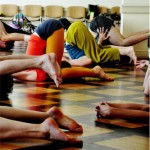PHILOSOPHY
“The central experience in new dance is to experience the intimate connection of the physical gesture, and generally of every external movement, with something internal, with emotion.” – Kurt Joss
Having trained in different styles both in Germany and the U.S., I have a great appreciation for the ways I am able to move and support my physical body. Indeed, because of my widely diverse training, I am aware now of what I need to do to preserve and encourage the development of my personal style as well as strengthen and align my body in harmony with its build. In my opinion, this level of physical awareness will only help me to have a long and fruitful artistic career.
To foster these feelings within my students, I begin class with floor work. Using the floor for placement and Bartenieff Fundamentals exercises for a guide, I imagine different ways for my students to connect the body distally to its core. As I see it, beginning class in this way positions our bones properly within our bodies and therefore encourages less muscular tension than is normal in everyday life — allowing the muscles to function with optimal effect and minimal effort.
In addition to the initial floor work, the class includes a blend of ballet and modern dance exercises that focus on natural, physical placement, efficiency of breathing, musicality, energy, weight, connectivity, suspension, and stability between the body systems we need while moving on and off balance.
In my class, students gain an understanding of muscular and skeletal function that allows them to release into their movement, increasing their own range. As a teacher, I believe that technique class should focus on kinetic awareness and not aesthetic preference. Only when the students know their bodies well can they dance their best.
As a teacher now, my ultimate goal is to feel the joy of movement while gaining knowledge of the basic principles of contemporary dance techniques. As a result of that goal, I include improvisational tasks in my class because I strongly believe in the unique power of personal expression. In my opinion, a teacher acknowledges not only the similarities between students but also the peculiar differences that are both beautiful to see and valuable to discover. In my class, students are encouraged to develop an individual style that embodies artistic freedom driven by the specificity of their physiques. After all, supporting students’ unique qualities in the classroom allows them to trust both their teacher and themselves. Ultimately, my purpose in teaching others to dance is to assist them in being well-trained, passionate, expressive, personally ambitious, responsible, and creative individuals driven by a desire to learn.
Patricia Noworol








